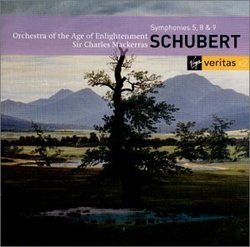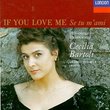| All Artists: Franz [Vienna] Schubert, Charles Mackerras, Orchestra of the Age of Enlightenment Title: Schubert: Symphonies Nos 5, 8 & 9 /OAE * Mackerras Members Wishing: 0 Total Copies: 0 Label: Virgin Veritas Release Date: 10/10/2000 Album Type: Import Genre: Classical Style: Symphonies Number of Discs: 2 SwapaCD Credits: 2 UPC: 724356180628 |
Search - Franz [Vienna] Schubert, Charles Mackerras, Orchestra of the Age of Enlightenment :: Schubert: Symphonies Nos 5, 8 & 9 /OAE * Mackerras
 | Franz [Vienna] Schubert, Charles Mackerras, Orchestra of the Age of Enlightenment Schubert: Symphonies Nos 5, 8 & 9 /OAE * Mackerras Genre: Classical
|
Larger Image |
CD DetailsSimilarly Requested CDs |
CD ReviewsFINISHED MASTERPIECES DAVID BRYSON | Glossop Derbyshire England | 07/14/2003 (5 out of 5 stars) "To get this much good-to-great music in high-quality sound for a low price could be called an outstanding bargain. When in addition the performances vary from very good to absolutely superlative, we are out of the mundane world of bargains altogether. To start somewhere, this is in some ways the best Great C Major I have ever heard. The accounts of the 5th symphony and the Rosamunde ballet music will also stand comparison with the very best. Beecham was unique for sure in the 5th, but neither that nor anything in Rosamunde is the greatest Schubert. The Great C Major is, for me, his ultimate masterpiece: its second movement is, for me, the most sublime slow movement in all symphonic literature, and here Mackerras simply surpasses everyone else I know - and then does the same again in the Scherzo & Trio. His handling of the outer movements seems to me more a matter of personal taste. You will get an idea what to expect after a few words on the Finished Symphony in B minor. Mackerras takes a straightforward approach to the familiar Allegro and Andante, as indeed to everything else on these two discs. Tempi are not too slow, the expression is natural and unaffected, the playing is magnificent. It is all a beautiful fusion of scholarly care and a deep feeling for the uniqueness of the inspiration. At this level of interpretation, preferences are a matter of temperament, but if you buy these two discs for these two movements alone you will not have made a mistake. However you will also find here a reconstruction of the Scherzo & Trio from Schubert's sketches by Brian Newbould plus the dear old B minor entr'acte from Rosamunde doing a turn as the 'finale'. The Scherzo material is promising, but one suspects that the composer knew that it would need supplementing to bring it up to the level of its great companions. As for the B minor entr'acte, it does not sound to me like a finale to anything, whatever Grove and the unnamed modern scholars may think. I am happy to have it just for itself. The C major starts fast, the speed exactly half that of the Allegro ma non Troppo, so that there is no speeding up in the transition. Mackerras does not slow down for the second subject, he makes the exposition repeat, and he takes the final statement of the opening theme at the speed of the Piu Allegro coda, i.e. rather fast just like at the start. In the early 1950's I heard a version of this symphony by Krips with the Concertgebouw that came nearer than any other -- before Mackerras -- to my idea of it. This was despite a flaccid Scherzo and an irritating way of anticipating the beat in the two Andantes. Krips took the opening Andante slowly, speeded up for the Allegro, omitted the repeat, did not slow down for the second subject but broadened his speed markedly for the final appearance of the opening theme. Recent practice is more in line with Mackerras - but do you believe that unifying the tempo is something vital or, as I think, of no relevance whatsoever? How fast the opening Andante should be is an issue indeed, and I still prefer the more measured tempo from Krips. Tying its speed to the Allegro leaves me indifferent, and I have yet to be convinced that Mackerras is not simply too fast in his final presentation of the opening theme. The second and third movements are just perfect. After all these years Mackerras gives the first account of the Scherzo & Trio that has satisfied me, and especial mention must be made of the glorious hurdy-gurdy tone of the woodwind in the Trio. The last movement depends utterly on that stupendous tune - if there is a greatest tune in all the world, surely this is it. But it does not need over-playing as by Furtwangler or Toscanini, nor over-phrasing as by Boult. Mackerras, like Krips, underplays it beautifully. The other thing it does not need is repeating, and unfortunately at the time of this recording the 'Repeats-Are-Compulsory' reign of terror was at its height. And that is the solitary fault I have to find with Mackerras in this finale. The sound of the period instruments is gorgeous. Normally you will not find me frantic to hear Authentic-As-Never-Before Messiahs; and I positively flinch at any threat of fortepianos. But when scholarship and musicianship combine as here, I am convinced. The orchestral balance is natural too - the thrill I get from Krips's tramping 2-bar polka rhythm in the first movement development or his hushed but oddly prominent accompaniment to the tune in the finale is probably an illicit pleasure connived at by the recording engineers in a way that would not be tolerated today. Technically Mackerras is a far better conductor than Krips, and I now have a better idea of how my favourite symphony bar none ought to sound." Insight into an Internal Stuggle. Peter Miller | LaGrange, GA | 12/01/2007 (5 out of 5 stars) "I think most people do not realize how much Franz Peter Schubert (1797-1828) experimented in the symphonic form. One thing that connects Schubert to Beethoven was how much experimentation was going on, but it was through a life that was much shorter. Both struggled with internal demons, but in the end they used the large form of the symphony as their method of emotional release. Most scholars agree that Beethoven went through three time periods of creative development (up to 1802, 1803-1814, 1815-1827) that were marked by great changes in his life. Schubert can be found to have the same three periods so let me explain them. Early Schubert is represented by his school years and a little after with music compositions roughly up to 1820. During this period, Schubert established himself as a song composer with the Erlking, the Trout, and Gretch and the Spinningwheel. He also finished 6 symphonies and two fragments of symphonies (D. 2b and D. 615). Symphony No. 5 which is very closely linked thematically to Mozart's Symphony No. 40 comes out as the most popular of these symphonies and Mackerras and the OAE do a fantasic job of keeping in the classical genre with a beautiful job on period instruments. Getting into the second period of Schubert is like a train slowly picking up speed. He starts off with a grand symphonic gesture (D. 708) but, he leaves that as a fragment of much promise. Next he moves onto the grand experiment of the symphony written in score, No. 7 in E Major (D. 729). Here we find Schubert moving more away from the classical symphony, but it gets bogged down by the experiment. He doesn't finish the orchestration leaving a symphony of bones with little connecting material. Now we move onto what I consider the first truely Romantic symphony, the Unfinished (well we see that is redundant), No. 8 in b minor (D. 759). Scholars disagree with why he didn't finish it, but what happened to Schubert may hold a clue. He contracted syphilis in late 1822 right as he was working on this symphony. Did he just stop because of the illness? Did he have a sketch of the finale and use it later? The are interesting questions with no clear answer. What many scholars have done is use the b minor En'tract from Rosamunde as the finale because of the key. Why? Well I've heard it said that this isn't much of a finale. What if it was and the illness just caused the creative juices of Schubert to give out for lack of energy physically? Well, Mackerras and the OAE give a resounding performance that demonstrates to me that even thought the En'tract isn't quite on par with the first three movements, it is a move that just might be what Schubert originally intended only he fell short. Schubert's letters indicate that he was trying to create a new model for the symphony. Now the last period of Schubert, 1823 until 1828 a period of personal struggle for Shubert. 1823 and 1824 are void of many large works as he fought his illness. 1825, however, showed Schubert on a creative binge. He took the very famous trip to Gmunden and Gastein that year and through letters he said he was creating a large symphony. The Octet of 1824 (D. 804) was his sketchbook where he experimented with themes and grand ideas. He wrote a large symphony that year in E Major (D. 849), but scholars want to shoot it down because of its mysterious history. One can find this on cd with the CCM Philharmonia Orchestra (I know because I gave a copy of the score to Gerhard Samuels after he asked me to find a symphony that hadn't been recorded yet...nice homework, huh?) That work was too difficult for any period orchestra to play. Schubert's experiments went foul again. One experiment of that work is the order of movements where he copied Beethoven's 9th (Fast, Scherzo, Slow, Fast). The symphony is full of earlier melodic elements of Schubert's including the Octet, Wanderer, and the Death and the Maiden string quartet. Here we find Schubert conquering is length problem and he gives us a work that is nearly an hour long. As for difficulty, listen to the first movement, and the last variations of the slow movement in the strings. Now this work got lost and forgotten until it showed up again in the late 1890's, but I move on. The last completed symphony of Schubert is the "Great" C Major (D. 944) which has a debated date, but I remember looking on the facsimile in 1992 and seeing that is was not 1825! The C Major is really and easier version of the E Major if you can believe that! He went back to the usual movement order and 'cleaned' up some themes to make them easier to play. Mackerras and the OAE again do a wonderful job here. I like that Mackerras doesn't 'mess' with the tempos in the first movement. His interpretation is beauty in it's simplicity. Now one other symphony remains by Schubert and this one would have blown the socks off of everyone had he lived to finish it. It is D. 936, which is really a miss on the numbering as he was working on it in the last weeks of his life. Syphilis was taking him down fast, but he wouldn't quit. He took some counterpoint classes the last weeks of his life and that is what he experiments with in the last symphony known as Symphony No. 10 in D Major. He uses canons, fugues, counter themes, and layering to bring this about. The first movement also moves around harmonically which is something he always tried to do but was limited by valveless brass. Well, valves were invented in 1815 and Schubert has some knowledge, but this gets too much into speculation. The slow movement is haunting to say the least and beautiful. The finale is a tour de force of canons and layering of themes. The coda is great when he layers the trombone theme and the bassoon theme together. By the way, Mackerras recorded that one too, and it is the best of the three available recordings. I hope my words can be of some service to you and if I've errored in any way, please feel free to correct me. Peter Miller" Very interesting for the period flavor, but not supreme inte Santa Fe Listener | Santa Fe, NM USA | 06/10/2006 (3 out of 5 stars) "In the Eighties, when these recordings were made, it was a relief to hear a period orchestra that could play entirely in tune. Under Mackerras's baton the Orchestra of the Age of Enlightenment dooes better than that--these performances have style and panache. The zing in the violin sound doesn't always sit well with me, and the violas and cellos are buzzy, but the wind sonority is tangy and interesting. The biggest plus, of course, is that Virgin's Veritas line gives us two full CDs for the budget price of one.
I'd rate the Sym. #5 as the best performance here--Mackerras is genial and relaxed, leaving himself enough room to make some nice points in phrasing and shaping the melodic line. Tempos aren't rushed but very well judged. The "Unfinished" has been interpreted by too many great conductors for Mackerras's straightforward reading, which punches at dynamics too much and avoids poetry too often, to be a complete winner. But as a period performance it fits the bill. As does the "Great" C major, which here is generally brisk--Mackerras takes th introduction to the first movement in alle breve, or cut time, as many period conductors like to do. The very long Andante goes by quicker than usual but moves at a dog trot. The finale is not played so hectically that the string players can't keep up, a flaw in many recordings. All in all, it would be hard to imagine a cheaper way to acquaint oneself with Schubert at his greatest in period style." |

 Track Listings (9) - Disc #1
Track Listings (9) - Disc #1

